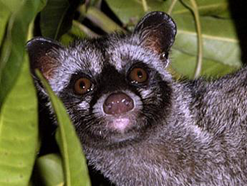Sambar deer and wild boars are wildlife most Singaporeans have heard of and may have previously encountered.
Civets, though, are more of a rarity. If you're unfamiliar with these rather exotic-looking creatures, here's a quick introduction.
Raccoon-like 'cat'
Civets are native to Singapore and are also known as civet cats, Toddy cats, or musang in Malay. One particular species, the Common Palm Civet, can be found on the island.
Contrary to their name, they are not cats and are instead more closely related to mongooses.
These creatures, which may look slightly similar to raccoons due to the dark band across their face, usually feed on fruits, insects and small animals.
 Photo by Nick Baker via NParks website.
Photo by Nick Baker via NParks website.
Civets might be best known for the product kopi luwak, a type of expensive gourmet coffee.
The coffee is made from coffee beans which have been eaten and excreted by civet cats. Due to demand for kopi luwak though, civet cats are sometimes poached and farmed inhumanely.
Cute civet wandering around at Telok Blangah
Several nature enthusiasts had a serendipitous encounter with a civet at Telok Blangah, near the Hort Park, on Nov. 10, 2019.
What was more surprising though, was that the animal was spotted foraging around the grass in broad daylight. Civets are typically nocturnal.
Here are some photos of them being sighted at night:
 Photo by Nick Baker via NParks website.
Photo by Nick Baker via NParks website.
 Photo by Nick Baker via NParks website.
Photo by Nick Baker via NParks website.
Surprisingly, this was apparently not the first time a civet was spotted in the same area in daylight -- the same group of people had chanced upon it feasting on a mango a few months back in the afternoon.
Here are some pretty clear photos of the civet which were posted to a nature-related Facebook group.
 Photo courtesy of Art Toh, Meilin Khoo and Peach Won
Photo courtesy of Art Toh, Meilin Khoo and Peach Won
 Photo courtesy of Art Toh, Meilin Khoo and Peach Won
Photo courtesy of Art Toh, Meilin Khoo and Peach Won
 Photo courtesy of Art Toh, Meilin Khoo and Peach Won
Photo courtesy of Art Toh, Meilin Khoo and Peach Won
Here's an adorable video of it examining some rocks, sniffing around on the grass, and doing typical civet things.
Video courtesy of Art Toh, Meilin Khoo and Peach Won
Some Facebook users speculated about why the civet was venturing out in the day, which was atypical.
One commenter guessed that the civet might have vision problems, and thus had came out in the day so that foraging would be easier.
Another commenter agreed that this was likely the case, and that the civet might be getting on in age.

However, she surmised that the civet looked quite healthy, and it looked alert.

Advisory
Here's what you should do if you ever encounter a civet:
- Do not be alarmed as the civets are shy and will try to stay out of sight so just leave them alone. If you are really interested, you can watch them from a distance and do not try to corner or chase them.
- Civets may eat leftover cat food that is left out in the open, so do keep your pets' food indoor if civets are sighted near your neighbourhood.
- If you find baby civets in your property, leave them alone as the mother will respond to them when they cry. The baby civets will start venturing out within two or three months after birth. After that, they will follow their mother to forage and will move out of your property eventually.
Top photo courtesy of Art Toh, Meilin Khoo and Peach Won
If you like what you read, follow us on Facebook, Instagram, Twitter and Telegram to get the latest updates.
